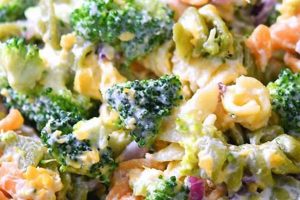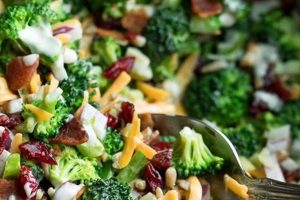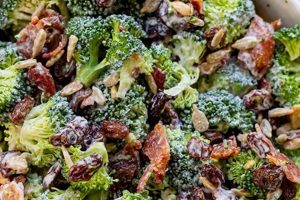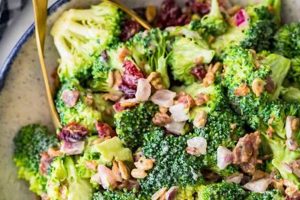A plant-based version of the classic broccoli salad omits traditional ingredients like mayonnaise, cheese, and bacon, replacing them with flavorful, animal-free alternatives. This typically involves a creamy dressing made from ingredients like vegan mayonnaise, tahini, cashew cream, or nutritional yeast, combined with fresh broccoli florets, other vegetables (such as carrots, red onion, or raisins), and often seeds or nuts for added texture and nutrition.
Such culinary adaptations cater to dietary restrictions and ethical preferences, offering a nutritious and delicious option for those following a vegan lifestyle. By omitting animal products, these recipes often reduce saturated fat and cholesterol content while boosting fiber intake. Historically, veganism has seen a surge in popularity driven by health, environmental, and animal welfare concerns, leading to increased demand for plant-based versions of traditional dishes. This has spurred culinary innovation, resulting in diverse and flavorful alternatives that often rival their traditional counterparts.
The following sections will explore specific ingredient options, dressing variations, and techniques for preparing a flavorful and satisfying plant-based broccoli salad. Nutritional information, tips for storage and serving, and variations to accommodate different tastes and preferences will also be discussed.
Tips for Crafting a Delicious Vegan Broccoli Salad
Achieving a flavorful and satisfying vegan broccoli salad requires attention to detail and a balance of flavors and textures. The following tips offer guidance for optimal results.
Tip 1: Blanch the Broccoli: Briefly steaming or blanching the broccoli florets ensures a vibrant green color and tender-crisp texture. Avoid overcooking, which can lead to a mushy consistency.
Tip 2: Explore Dressing Variations: Experiment with different base ingredients for the dressing, such as vegan mayonnaise, tahini, cashew cream, or a combination thereof. Nutritional yeast adds a cheesy flavor profile.
Tip 3: Enhance Flavor with Acidity: A touch of acidity balances the richness of the dressing. Apple cider vinegar, lemon juice, or rice vinegar are excellent choices.
Tip 4: Add Textural Contrast: Incorporate ingredients like sunflower seeds, toasted slivered almonds, dried cranberries, or chopped red onion for textural complexity.
Tip 5: Season Thoughtfully: A balanced seasoning profile is crucial. Consider using garlic powder, onion powder, smoked paprika, or a pinch of cayenne pepper for depth of flavor.
Tip 6: Chill Before Serving: Allowing the salad to chill in the refrigerator for at least 30 minutes allows the flavors to meld and enhances the overall experience.
Tip 7: Customize to Preference: Adapt the recipe to individual preferences by adding other vegetables like shredded carrots, bell peppers, or chopped celery.
By following these tips, one can create a vegan broccoli salad that is both nutritious and enjoyable. Attention to detail and thoughtful ingredient selection are key to achieving optimal flavor and texture.
This exploration of tips provides a strong foundation for creating a successful vegan broccoli salad. The following section will offer a complete recipe incorporating these principles.
1. Fresh Broccoli
Fresh broccoli serves as the central component of a successful vegan broccoli salad. Its quality significantly influences the final dish’s overall flavor, texture, and nutritional value. Selecting and preparing fresh broccoli correctly is essential for optimizing the salad’s appeal.
- Visual Indicators of Freshness
Vibrant green color, compact florets, and firm stalks signify fresh broccoli. Avoid broccoli with yellowing florets, wilted leaves, or a strong odor, as these indicate aging or spoilage. Freshness directly correlates with optimal texture and flavor in the finished salad.
- Nutritional Value
Fresh broccoli is a rich source of vitamins, minerals, and fiber. These nutrients are retained best when the broccoli is handled and prepared correctly. Minimizing cooking time helps preserve vitamin C content, contributing to the salad’s nutritional value.
- Preparation Techniques
Proper preparation enhances both the flavor and texture of broccoli in the salad. Washing thoroughly removes any debris, while careful chopping ensures even cooking and a pleasant mouthfeel. Blanching or lightly steaming the broccoli florets creates a tender-crisp texture, enhancing their appeal in the salad. Overcooking leads to a mushy texture, detracting from the salad’s overall quality.
- Storage and Shelf Life
Proper storage maintains freshness and extends shelf life. Refrigerating unwashed broccoli in a loosely closed bag or container helps preserve its quality. Consuming the broccoli within a few days of purchase ensures optimal flavor and nutritional value in the salad.
Prioritizing fresh, high-quality broccoli contributes significantly to a vegan broccoli salad’s success. Careful selection, proper preparation, and appropriate storage ensure the broccoli retains its nutritional value, vibrant color, and desirable texture, ultimately enhancing the salad’s overall appeal.
2. Creamy Vegan Dressing
Creamy vegan dressing forms an integral part of a successful broccoli salad vegan recipe. It provides the essential element of richness and moisture that binds the other ingredients together, significantly impacting the overall flavor and enjoyment of the dish. The dressing’s composition, texture, and flavor profile play a crucial role in complementing the broccoli and other salad components.
- Base Ingredients
The foundation of a creamy vegan dressing determines its texture and flavor. Common bases include blended cashews, silken tofu, tahini, or vegan mayonnaise. Each option offers a unique flavor profile and consistency. For example, cashew-based dressings tend to be rich and slightly sweet, while tahini offers a nutty, earthy flavor. The choice of base ingredient significantly influences how the dressing interacts with the broccoli and other salad components.
- Flavor Enhancers
Flavor enhancers elevate the dressing beyond its base, adding complexity and depth. Nutritional yeast contributes a savory, cheesy flavor, while lemon juice or apple cider vinegar provide brightness and acidity. Dijon mustard adds a tangy kick, and garlic or onion powder contribute savory notes. These elements work synergistically to create a well-rounded and balanced flavor profile that complements the broccoli’s natural flavors.
- Texture and Consistency
The dressing’s texture plays a vital role in coating the broccoli and other ingredients evenly. A smooth, creamy consistency is typically desired, achieved through blending or whisking. The thickness can be adjusted by adding more or less liquid. Achieving the right consistency ensures that the dressing clings to the broccoli, delivering flavor in every bite while avoiding a watery or overly thick texture.
- Nutritional Considerations
Vegan dressings offer opportunities to incorporate nutritional benefits. Cashew-based dressings contribute healthy fats and protein, while tahini provides calcium and iron. Nutritional yeast is a source of B vitamins. These nutritional aspects add value to the salad beyond flavor and texture, aligning with the health-conscious nature of many vegan diets.
The creamy vegan dressing serves as a unifying element in a broccoli salad vegan recipe. Its careful consideration and preparation elevates the dish beyond a simple combination of ingredients, transforming it into a cohesive and flavorful culinary experience. The synergy between the dressing and the other components, particularly the broccoli, determines the salad’s overall success. By understanding the interplay of base ingredients, flavor enhancers, texture, and nutritional considerations, one can craft a dressing that perfectly complements the broccoli and other ingredients, resulting in a truly satisfying and delicious salad.
3. Balanced Flavor Profile
A balanced flavor profile is paramount in a successful broccoli salad vegan recipe. This balance hinges on the interplay of sweet, sour, salty, bitter, and umami elements, creating a harmonious and palatable experience. Without this careful orchestration, the salad can become one-dimensional, with certain flavors overpowering others. For instance, a dressing that is excessively sweet can mask the broccoli’s subtle bitterness and the other components’ nuanced flavors. Conversely, a dressing lacking acidity can make the salad taste bland and heavy. A well-balanced profile ensures each ingredient contributes to the overall taste experience without dominating it.
Achieving this balance involves strategic ingredient selection and precise proportions. Acidity, often from vinegar or citrus juice, provides brightness and cuts through the richness of the dressing. A touch of sweetness, from maple syrup or agave nectar, balances the tartness. Salt enhances the other flavors, while umami, derived from ingredients like nutritional yeast or soy sauce, adds depth and savoriness. Consider a lemon-tahini dressing: the lemon’s tartness balances the tahini’s richness, while a pinch of salt and a dash of maple syrup round out the flavor profile. This balance prevents any single flavor from dominating, resulting in a more complex and enjoyable salad.
The practical significance of a balanced flavor profile extends beyond mere palatability. It elevates the sensory experience, making the salad more satisfying and memorable. Furthermore, it highlights the individual flavors of the ingredients, allowing the broccoli, other vegetables, and dressing to shine through. This balance is essential for transforming individual components into a cohesive and delicious whole. Mastering this balance is crucial for creating a broccoli salad vegan recipe that is both nutritious and truly enjoyable.
4. Textural Variety
Textural variety is a critical element in a successful broccoli salad vegan recipe. A compelling interplay of textures elevates the eating experience beyond mere sustenance, transforming it into a multi-sensory delight. A monotonous texture, regardless of how flavorful the ingredients, can result in a less satisfying dish. Consider the contrast between the crisp-tender broccoli florets and the creamy dressing; this textural interplay is essential for a dynamic and enjoyable salad.
- Cruciferous Foundation
Broccoli, the foundational ingredient, offers a naturally slightly crisp texture, particularly when properly blanched. This inherent textural element provides a base upon which other contrasting textures can build, creating a more engaging culinary experience. Overcooked broccoli, however, loses this crispness, resulting in a less appealing, mushy texture that detracts from the overall salad.
- Creamy Counterpoint
The dressing, often creamy and smooth, provides a textural counterpoint to the broccoli. This contrast between the crisp-tender broccoli and the smooth dressing enhances the overall enjoyment. Whether a cashew-based, tahini, or vegan mayonnaise dressing, the creamy texture coats the broccoli, creating a pleasing mouthfeel and ensuring the flavor is evenly distributed.
- Nuts and Seeds: Crunchy Complements
Incorporating nuts and seeds introduces a crunchy element that further diversifies the textural landscape. Sunflower seeds, toasted almonds, or pumpkin seeds offer satisfying pops of crispness that contrast with both the broccoli and the creamy dressing. These additions prevent textural monotony and create a more dynamic eating experience.
- Dried Fruit: Chewy Accents
Dried fruits, such as cranberries or raisins, contribute a chewy texture that adds another layer of complexity. These chewy accents provide bursts of sweetness and a textural counterpoint to the other ingredients, further enhancing the overall sensory experience. The combination of crunchy, creamy, chewy, and crisp-tender elements results in a salad that is far more engaging than one with a uniform texture.
The interplay of these varying texturescrisp-tender broccoli, creamy dressing, crunchy nuts and seeds, and chewy dried fruitelevates the vegan broccoli salad from simple to sophisticated. This textural diversity is integral to a satisfying and memorable culinary experience. A well-executed broccoli salad vegan recipe understands and leverages these textural nuances, creating a dish that is as enjoyable to eat as it is nutritious.
5. Proper Chilling
Proper chilling is essential for a successful broccoli salad vegan recipe. Chilling allows the flavors of the various componentsthe broccoli, dressing, and other additionsto meld and harmonize. This process of flavor integration enhances the overall taste experience, creating a more cohesive and balanced final product. Without adequate chilling, the individual flavors remain distinct, resulting in a less unified and potentially less satisfying salad. For instance, a freshly made salad might taste predominantly of the dressing, with the broccoli and other ingredients playing secondary roles. After chilling, the flavors blend, allowing the nuanced notes of each component to emerge and complement one another. This integration creates a more complex and enjoyable flavor profile.
Furthermore, chilling enhances the textural aspects of the salad. The broccoli, especially if blanched, benefits from chilling as it firms up slightly, retaining a desirable crisp-tender texture. The chilling process also allows the dressing to thicken slightly, improving its ability to cling to the broccoli and other ingredients. This ensures each bite delivers a balanced combination of flavors and textures. A warm salad, conversely, might have a wilted or soggy texture and a less cohesive flavor profile. The practical application of this understanding is straightforward: chilling the salad for an adequate period, typically at least 30 minutes, significantly enhances both its flavor and textural appeal.
In summary, proper chilling is not merely a final step but a crucial stage in developing a flavorful and texturally satisfying broccoli salad vegan recipe. It allows for flavor integration and textural enhancement, transforming individual ingredients into a cohesive and delightful culinary experience. The practical significance of this understanding is clear: allocating sufficient chilling time is essential for optimizing the final product’s quality and enjoyment. This underscores the importance of planning and time management in culinary endeavors, emphasizing that even seemingly simple steps like chilling play a significant role in achieving optimal results.
Frequently Asked Questions
This section addresses common inquiries regarding the preparation and enjoyment of vegan broccoli salad.
Question 1: What is the best way to prevent the broccoli from becoming mushy in the salad?
Blanching the broccoli briefly in boiling water, followed by an immediate ice bath, helps maintain its crisp-tender texture. Avoid overcooking.
Question 2: Can the dressing be made in advance?
The dressing can be prepared a day or two in advance and stored in an airtight container in the refrigerator. This allows the flavors to meld and deepen.
Question 3: What are some suitable alternatives to vegan mayonnaise in the dressing?
Cashew cream, tahini, or a combination thereof offer excellent alternatives, providing creamy texture and distinct flavor profiles.
Question 4: How long can vegan broccoli salad be stored?
Properly stored in an airtight container in the refrigerator, the salad can typically last for three to five days, though its quality may gradually decline.
Question 5: Can frozen broccoli be used in this recipe?
While fresh broccoli is preferred for optimal texture, frozen broccoli can be used in a pinch. Ensure it is thoroughly thawed and drained before incorporating it into the salad.
Question 6: How can the nutritional value of the salad be enhanced?
Adding ingredients like sunflower seeds, pumpkin seeds, or chopped nuts boosts the salad’s protein, healthy fats, and mineral content.
Understanding these common points of inquiry can contribute to a more successful and enjoyable experience when preparing vegan broccoli salad. Addressing potential challenges proactively ensures optimal results.
This FAQ section provides a comprehensive resource for addressing common concerns. The next section will offer a complete recipe incorporating the principles and tips discussed throughout this article.
Vegan Broccoli Salad
This exploration has delved into the multifaceted nature of crafting a successful vegan broccoli salad. From the selection and preparation of fresh broccoli to the nuances of creating a balanced and flavorful dressing, each component contributes significantly to the final dish. The importance of textural variety, achieved through the incorporation of nuts, seeds, and dried fruits, has been highlighted, alongside the crucial role of proper chilling in allowing flavors to meld and textures to optimize. Addressing common inquiries regarding ingredient substitutions, storage, and potential challenges provides a comprehensive resource for culinary enthusiasts seeking to create a truly exceptional vegan broccoli salad.
The adaptability and inherent nutritional value of this dish position it as a versatile and healthful option within the expanding landscape of plant-based cuisine. Continued exploration of flavor combinations and ingredient variations promises further culinary innovation within this realm, offering exciting possibilities for both novice and experienced cooks alike. Embracing the principles outlined herein empowers individuals to create a vegan broccoli salad that is not only delicious but also a testament to the versatility and richness of plant-based gastronomy.






